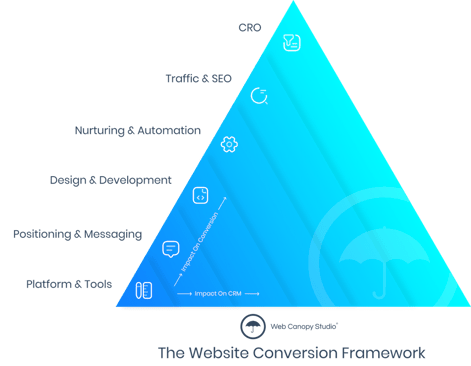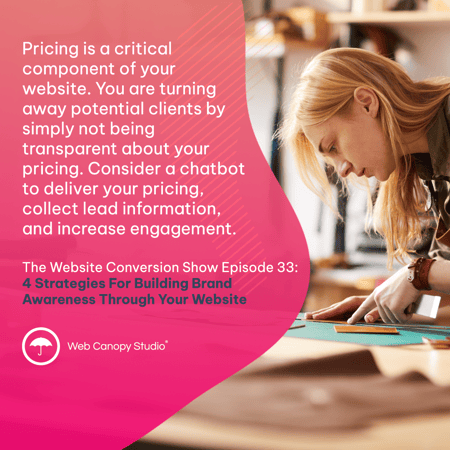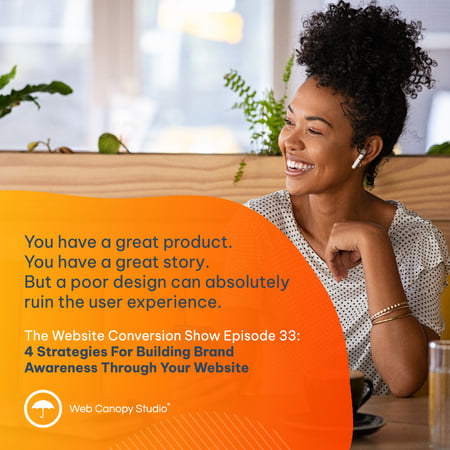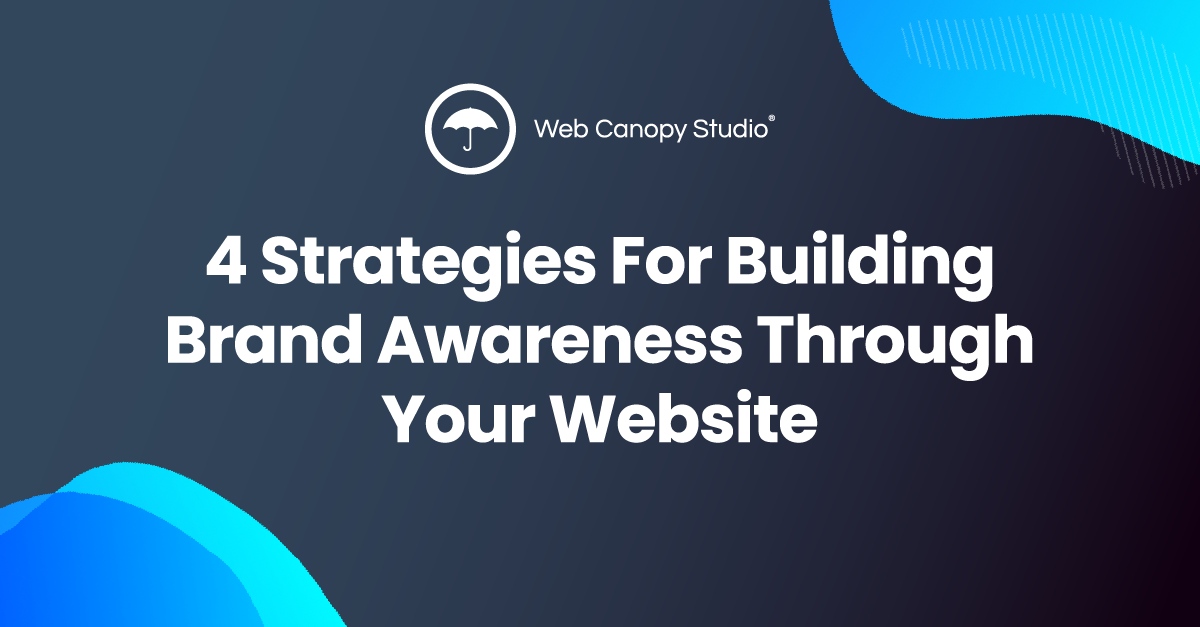Brand awareness is one of the most important aspects of a marketer's job.
It often sits in the back of our minds as something that we need to be focusing on, but the problem is that it’s one of the most difficult things to measure.
So how do you work on brand awareness without spending a ton of money on outbound strategies that are expensive?
To answer this, we'll go over four amazing strategies for increasing brand awareness through your website:
- Engagement with Interactivity
- Design with Storytelling
- Consistent Content Style
- Building a Community
But, before we get into these effective strategies, we need to understand the Website Conversion Framework and how brand awareness fits into it.
The Website Conversion Framework

The Website Conversion Framework contains the six key areas that your website must go through in order to consistently produce a high-converting website.
We need to keep coming back to each level of the Website Conversion Framework, as shown in the diagram above, and ensure we’re doing what’s necessary to deliver the right message to our audience.
Why are we doing this?
Because in reality, the website is the biggest sales tool that you have.
When it’s used correctly, it will absolutely be the secret to make your marketing and sales work effectively.
Brand Awareness can be impacted at many of these levels, however we’re going to focus specifically on the third level of the Website Conversion Framework, which is design and development.
Typically, we see people looking at this from an outbound perspective:
- Social media campaigns.
- Ad campaigns.
- Billboards and commercials.
- Outbound calling campaigns.
- etc.
And it’s true that these are effective ways to accomplish that because they form a very critical piece of brand strategy.
However, what most people don’t realize is that brand awareness can be built internally through your own website with some consistency.
So let’s zero in on our first strategy for building brand awareness, engagement with interactivity.
1. Engagement With Interactivity
This concept revolves around the idea of making your website engage with your audience when visitors come to you.
You want to give them the chance to interact with you in ways they don't usually get elsewhere or aren't used to.
Chatbots
This can be achieved in so many ways, but one of the easiest is to implement a chatbot strategy.
Chatbots have a lot of negative connotations from a user perspective.
Many of us think of chatbots as a tool that doesn't really provide a whole lot of value.
It is typically viewed as something to obnoxiously click through in order to get to talk to a sales support representative. The reality is that chatbots can be so much more. We just have to think about intent.
Here’s a perfect example:
Many B2B SaaS companies have a difficult time feeling forward enough to share the costs of their product or the cost to work with them.
This is a roadblock, a barrier really, that a lot of marketers, CEOs, and leadership teams have to work through.
However, if we think in terms of gathering contact information in order to share pricing information, we generally let our guard down.
Using a chatbot to deliver a pricing quote is extremely low barrier and high on the engagement scale.
Asking simple, multiple choice questions via chatbot allows your prospects to choose from the options you’re giving to them, and in turn they are able to adjust the quote size up or down.
We've had many clients do this with us as well, and it's a very effective measure to get people to engage (and ultimately have a memorable brand experience).
The beautiful win-win scenario here is that the prospect is able to get answers to their important questions (like cost associated with your service), you’re able to keep your pricing information close to your chest except for those willing to engage with you, and your sales team is actually able to collect all the lead information from each and every question they are asked.
That means, as a sales person, I would now be armed with every piece of critical information I would need to increase my chances of closing that deal.
How would you do this?
Well, you can use any number of tools out there, but we recommend:
- HubSpot
- Outgrow
- Drift
Assessments & Quizzes
Another great way to increase engagement is to create a quiz or survey to conduct an assessment.
Here’s an example:
We have a self-guided assessment on our website called the Website Conversion Assessment.
With this tool our prospects can see how well their website performs in the six different levels of the Website Conversion Framework just by answering a handful of impactful questions.
As a result, the assessment continue the brand awareness process by delivering a series of results for each section:
- A score.
- Suggestions in the report on how to improve in specific areas.
- A checklist of tasks to increase your score.
- Information on how this ties back to your CRM performance.
- And additional recommendations and resources for solving your problems.
By having some kind of interactive element on your website:
- You're improving the user experience
- You're improving their time on the page
- You’re building their trust with you
- and you're building brand awareness and comfort with you, little by little

2. Design With Storytelling
The overall message your website conveys is so important.
Through your website, you're telling a story that helps the visitor see the journey that they're on, the path they’re taking, and how they can solve their problems.
Ultimately, that path is leading them towards utilizing your product or your service in order to achieve their goals.
That being said, the design needs to accentuate that story rather than detract from it.
A great example of this would be looking at the features page of any product.
Most products (I’m talking to you, SaaS brands) fill their product pages with how cool their product features are and why they are awesome.
But instead of listing those features and explaining what the customer would get, I would first look at the journey they are on.
Do they really care about the features of the product when they’ve never heard of our company in the first place?
The answer is… probably not.
I would give a small paragraph of content about the problem the customer has, followed by a quick explanation of how that problem is solved with a single feature.
The kicker here, is I would design it in such a way that it has a graphically pleasing, back and forth flow throughout; This should move people down the page, utilizing white space (or open space) frequently, and really emphasize lifting up the story through design.
I'd do it in such a way that it almost makes perfect linear sense for the person to walk through that journey and continue experiencing the story with us.
Look at this kind of page layout from the perspective of a person walking down a path, and you know they subconsciously have these problems and issues in the back of your head.
You’re almost laying out the red carpet for them with short, distinct, problem and answers laid out for them, and you’re one step ahead of thinking of the next issue they are going to have.
You’re preemptively knocking down their barriers, one at a time.
Keep in mind, you have a great story already.
You have a great product or a great service, and you're conveying that through the content which your design must support.
We can tell that story in a lot of different ways, but the design of how we share it is so critical.
Why does this impact brand awareness?
I’ll put it plainly:
Deliver an amazing user experience while you answer the problems your customer has, and you are going to have a very memorable and meaningful website that they will continue to come back to (and will likely share with colleagues).
This way of looking at things holistically brings us to our next strategy for building brand awareness which is maintaining a consistent content style
3. Consistent Content Style
Maintaining a consistent content style is essential to your marketing strategy, but you’d be surprised how many brands have completely different styles and experiences that are created for their clients.
How are we building a visual brand experience if everything looks different, is not cohesive, etc.?
You’re not.
Many of you are already regularly blogging, sharing on social, and more, which is phenomenal.
What we want to do is be predictable.
We want to be consistent.
And we want to be consistent with the style.
How can we do that?
If your website is chopped up and has a million different templates or themes… or you’re using a ton of different platforms with all kinds of different plugins and tools… or you’re using different graphic and writing styles all over the place…
That’s the place you want to start.
Maybe it's time to think, “How can we make this a very unified, consistent experience that our prospects and our customers can go through when they're looking at our website?”
Consider how that impacts brand awareness.
When somebody is engaging with one of your ad campaigns, one of your blogs, one of your social media campaigns, or anything else, they should get that same experience that’s predictable and consistent.
If it’s not, you’re preventing your brand from getting the recognition and recollection you could.
Long story short:
If you're distributing content, it has to look and feel consistent on every platform, and it has to be published in a predictable manner.
Really, building fans for life is huge, and that’s why it’s important to consider our next and last strategy for building brand awareness: building a community.

4. Building a Community
When you can build brand awareness by removing yourself from just being a “vendor,” you reach a totally different level of authority and recognition.
The goal is to help your company expand beyond that initial level of how they look at you now.
“Oh, that's who does my…”
You want to come across to your client so that they say to others: “I'm a part of this experience” and “I'm a part of this community.”
Implementing this strategy of building a community is the most long-term play of all the ones we’ve considered so far.
Building a community is a fantastic opportunity to bring in people to have a private, exclusive experience with your company.
It can be done in several ways (and honestly, we recommend using your website to do all of them):
- A membership
- Live events
- Online presentations
- An online course
- An online group
If you look at HubSpot, they do this extremely well with their partner community.
We don’t look at HubSpot as just a platform for us.
We see HubSpot as a community - as an experience for all of these amazing agencies, marketers, and developers to work together and learn from each other (and HubSpot!).
It's more than just, “HubSpot is our marketing automation tool.”
It's more than just, “we sell services to companies that are using HubSpot.”
It really is a community that is tied together through Facebook Groups, Slack communities, online events, in-person meetups, and so much more.
When you incorporate this into your strategy, you're building awareness and that brand reputation for life.
The Bottom Line
These four strategies for building brand awareness through your website are powerful ways to grow your business:
- Establish new and healthy relationships with your customers by means of engagement with interactivity.
- Design with storytelling in mind and lead your customers on a wonderful journey that presents them with solutions in a natural and free flowing way.
- Maintain a consistent content style throughout to give your visitors a comfortable and familiar feel.
- Build a community in order to strengthen the relationship with your customers and create a lifestyle brand experience.



